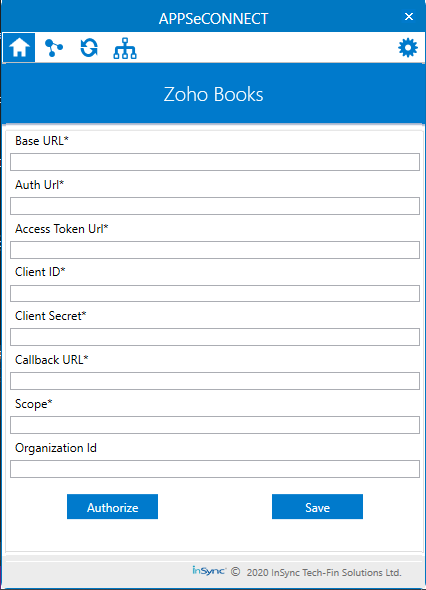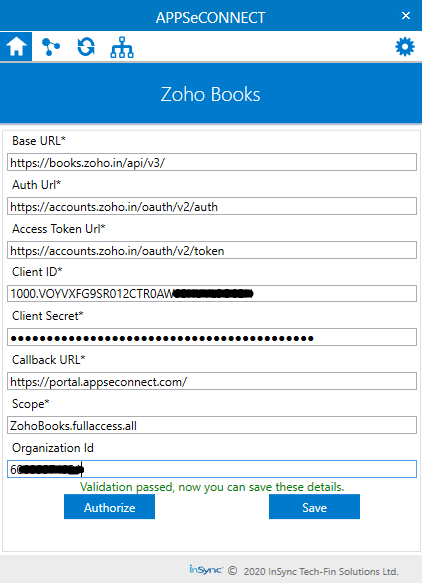ZohoBooks
Updated:
Application configuration is an integral activity prior to the process of integration. If your chosen application is Zohobooks credentials need to be provided for validating the agent. Here you will find the detailed description on how to configure the agents for the application of Zohobooks, Adapter Configuration, Attributes and action and the Troubleshooting issues.
Pre-requisites for Zoho CRM V2.0 Configuration
- Valid APPSeCONNECT Portal credentials.
- Select the Application ZOHOBOOKS in the APP section.
- Create a connection for ZOHOBOOKS.
- Publish a Touchpoint, Update Adapters and Update Configuration in the agent.To Know about Agent Configuration, Click here
Configure the ZohoBooks Application in the Agent
ZOHOBOOKS is a REST Application which supports the OAuth2.0 authentication. The Adapter of the application ZOHOBOOKS provides the leverage to communicate and adapt with the AEC Portal. This section provides you the detailed process of validating the credential of the application ZOHOBOOKS.
1) Go to App Configuration panel of the agent click on the + button, beside the app ZOHOBOOKS.

2) The Adapter configurations will get downloaded automatically (within a timespan), and then you can proceed with credential authorization.
3) The configurational fields for the credential templates get downoaded. You can now provide the credentials for your applications. The following fields are required for validating the your credentials. The Authentication fields for OAUTH 2.0 are:
- Base URL - You need to provide the base url of your zohobooks application.
- Auth URL - This URL is generated along with the Client ID and Client Secret in the REST application itself.
- Access Token URL - A client-authorized key that lets the client access protected resources from Zoho. The client can make API requests using this access token for up to an hour after the creation of the token.Enter the Access Token URL
- Client ID - This is generated when the client logs into the Application.
- Client Secret - This field is also generated by the REST supported Application.
- Call Back URL - This is the secondary URL required for data restoration.
- Scope - Scopes defines the specific actions applications can be allowed to do on a user behalf.
- Organisation Id - This is an optional field. However if your application supports organisation id, you can anytime provide your applications org id. For more details on Organisation Id, click here.
5) Provide your credentials as per the fields given.
6) Here, we need to generate token which can be done by clicking the AUTHORIZE button. A custom browser opens for validating and generating token for your chosen application.

7) Provide your application credentials until the login page of portal.appseconnect.com opens.

8) Keeping the browser opened, validate your credentials on your On-Premise Agent by clicking on the VALIDATE button. Your adapter will get validated successfully.
Following the above process you can sucessfully validate the adapter of zohobooks.
Note: Once, the credentials are validated, the user can close the Blank Window.
Troubleshooting
ISSUE 1: Some of the basic troubleshooting issue happens due to improper validations or even if it is accurately validated, and if touchpoints do not sync, this basic issue resolves after removing the Temp and Cache files from the portal and from your system. Therefore after clearing all this publish the touchpoints again along with Update Configuration on the agent.
For E.g. If the Source Application Not Found in the log file appears, the probable cause is due to the presence of the Temp and Cache Files.
Attributes and Actions
While defining a connect to a particular API endpoint in ZohoBooks, you require clear understanding about the data requirements
and endpoint configurations. You can refer to this document to find all the endpoint details of your ZohoBooks installation.
To define the endpoint in APPSeCONNECT, you need Actions and Entities. Actions are specifically targeted for a particular
endpoint while schema is the data needed to execute the API. Here, is the list of some of the pre-packaged API actions defined
for you which you can easily plug and play while doing your integrations. In ZohoBooks Customer is known as Account.
Note: Click Here to know more about the ZohoBooks API Documentation.
| Endpoint | Action | Action Type | Schema | API Path |
|---|---|---|---|---|
| contacts | contacts | GET | contacts | Fetch Contacts from ZohoBooks |
| contacts | contacts | POST | contacts | Create a new contact in Zohobooks |
| salesorders | salesorders | GET | salesorders | Fetch salesorders from zohobooks |
| salesorders | salesorders | POST | salesorders | Create a new salesorder from zohobooks |
| POST/items | POST/items | POST | POST/items | Create a new item |
| invoices | invoices | GET | invoices | Fetch invoices from Zohobooks |
| invoices | invoices | POST | invoices | Create new invoices from Zohobooks |






